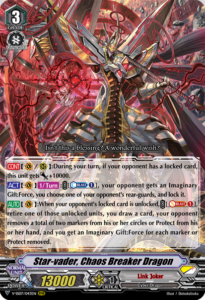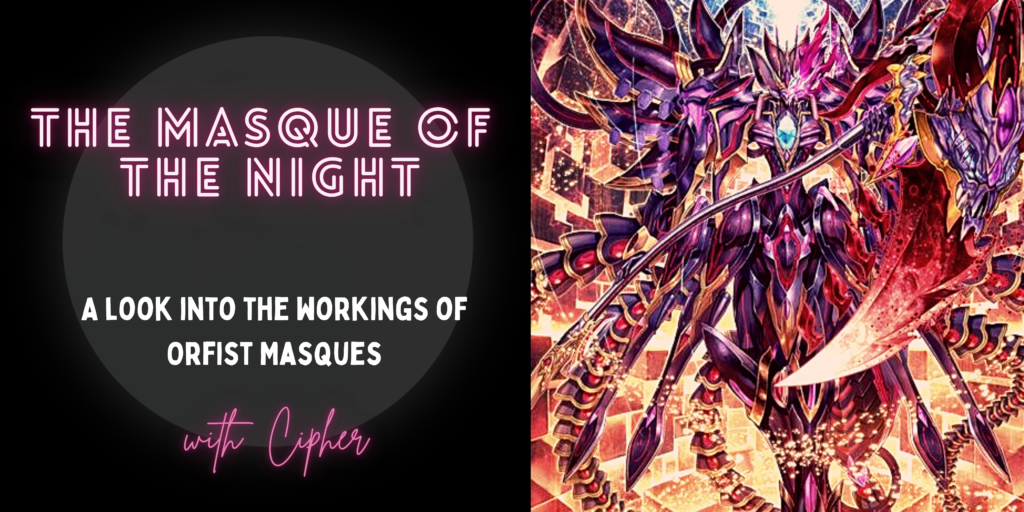
Cipher here! To launch the new site with a bang, I’ll be talking about Orfist! The original Cardinal Orfist has always been one of the coolest units, especially with its lore being tied to Link Joker. This time in Set 12, we return a little to the dark side with Orfist Masques.
Card Introduction
Orfist Masques is the next evolution and third form of Orfist and as usual, it specializes in using Shadow Army tokens but this time with a twist.
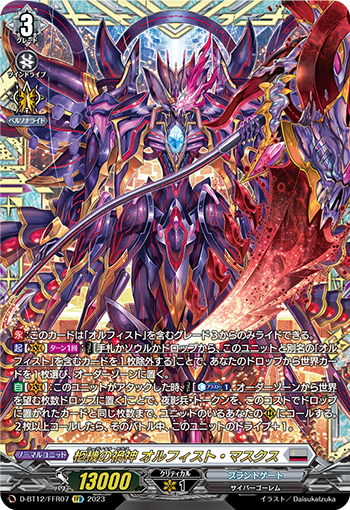
Cardinal Mors, Orfist Masques
[CONT]:This card can only be ridden from a grade 3 with “Orfist” in its card name.
[ACT](VC)1/Turn:COST [Remove a card with “Orfist” in its different card name from this unit from hand, soul, or drop], choose a World card from your drop, and put it into order zone.
[AUTO](VC):When this unit attacks, COST [Counter Blast (1) & put any number of World cards from order zone into drop], and call up to the same number of Shadow Army tokens as the number of World cards put into drop for this cost to (RC) with units. If you called two or more cards, this unit gets drive +1 until the end of that battle.
The first two skills are the standard for a Masques unit, the first being the usual ride restriction and the second having a cost to banish another version of itself (in this case, a differently named Orfist) in exchange for some form of plus, recursion or resource management – in this case putting a World order from your drop zone into the Order Zone which is pretty good.
Lets jump right into it with its 3rd skill – Masques actively throws away World Orders to spawn Shadow Army tokens. At first glance this might seem counterproductive to how Orfist decks have previously behaved – Orfist is a deck that works off the Dark Night/Abyssal Dark Night mechanic which requires World Orders to be in play to activate their skills.
This is very different from Regis in particular which scales with building up as many World Orders as possible. It is also important to note that you can only call to occupied rearguard circles as well, meaning you are trading your current units so in terms of board advantage, it does not actually create anything new by itself. At first glance, this can seem lackluster as you have to consider that you are running a Masques package which opens up a whole new issue. All that for just a guaranteed call and potential drive?
“Surely this is not worth it.”
The Underlying Problem With Masques
If you’re looking to utilise Masques at all, you increase your risk of bricking as you have to put in copies of Masque of Hydragrum – a card that does very little on its own but is an essential cog in the execution of the strategy. As that is easily one of the strongest parts of playing a Masques deck, you often end up committing more deck space to finding it too – many Masque decks tend to have a rather straight forward mold in how they are built, and generally give up some of the old support in favor of various Masque and Dragontree support pieces to make the strategy work. Masques of Hydragrum and specific rearguards which help build Dragontree markers and other effects that are often reliant on you to be already on the Masques Vanguard specifically. This also means that if we fail to draw into Masque Vanguard early enough, the rest of the deck risks become a worse version of its version.
In exchange for making those sacrifices and taking those risks, you gain sudden explosive power, especially when going second and the speed that the Masque deck could potentially play is often worth giving up a safer and more consistent game. Looking at it from a competitive perspective, in a landscape where Gandeeva, Wilista and even new decks like Bastion Accord exist, having a deck that is able to be strong going first or second is very powerful.
In contrast to most nations, however, Brandt Gate decks typically incorporate a substantial number of orders already. For Orfist specifically, about 7-8 slots are reserved for World Orders. When striving for a well-balanced deck, including more than 2 Masque Orders can be challenging and it often results in too many unplayable hands due to the lack of shield values for defense. This also creates an issue in that despite them being different types of orders, you can still only play one order per turn – if you play the Masque of Hydragrum, you will not be able to hard play a Set Order from hand for turn. Whilst by no means a unique problem with Masque decks, it is especially apparent for Brandt Gate as virtually all of their decks are based on set orders.
Why has Orfist been performing?
Let’s break the deck down into it’s most important pieces and examine what makes it work.
Polarxis Dragon
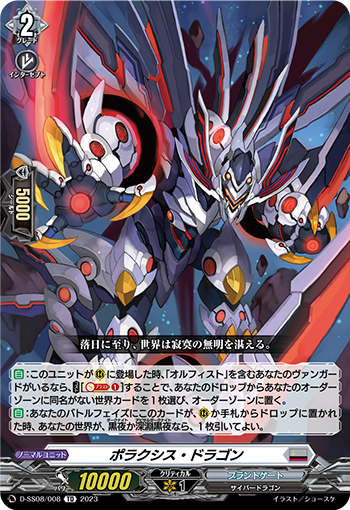
Orfist has gained some valuable staples with one in particular standing out: Polarxis Dragon. This Grade 2 unit is a unique addition to the Orfist Deck Set, boasting two impressive abilities. The first one activates when you have an Orfist Vanguard and a soul to spare. It allows you to place a World order from the drop zone provided you don’t already have a copy of it set, which will trigger the on-place abilities of the World Orders.
This skill is not only useful for Regis but truly shines when paired with its Masque counterpart. By discarding the orders you want to recycle, you’ll always have targets to reset, ensuring that this card remains relevant throughout the game. In contrast, Regis, which relies on building the order count, would usually struggle to activate this skill more than once unless you intentionally tailor your deck to work with it. Over time, the strategy involves playing Worlds from hand, using Polarxis and/or Orfist itself to rebuild the count, allowing Orfist Masques to ideally unleash a minimum of 2 worlds per turn for the added drive.
Its second ability holds significant power within all Orfist decks, serving as valuable discard material for Regis or an ideal rear-guard unit that grants you a card draw.
Another noteworthy aspect is that it only requires Dark Night and not Abyssal Dark Night This means that even if you’re left with just one World after resolving Orfist Masques, Polarxis Dragon will still activate its effect to draw one card. It’s crucial to keep this in mind because there may be situations where you need to make a decision between committing to strong push turns and foregoing the draw – you may want to intentionally empty your World count to avoid deckout.
Both of these skills provide the deck with an advantage engine when combined with Hollowing or Eclipsed Moonlight, which should be your primary choices when discarding Worlds for Orfist Masques. Keeping Polarxis Dragon in play whenever possible ensures that Masques has the necessary fuel to continue its momentum.
Another similar card is Habitable Zone, another very powerful card, that in my opinion could definitely see play in some variants of Orfist as it grants early game cycling and a way to cheat out an order from your deck. Normally the target we will take from it will be Overcoming the Eternity. Though its cost, especially the early soul blast, can hurt the deck’s curve. Still, it’s a card that some may consider but Polarxis is the better card in the deck.
The New Pieces and The Dragontree Marker
Like all Masque decks, Orfist Masques has dedicated followers and we’ll focus on two main cards. First, there’s Dragontree Wretch, Psyber Kaitul, a crucial card in Brandt Gate Masques decks. It searches for Masque of Hydragrum and generates a Dragontree Marker, although it’s a costly card to play. However, resolving it is vital because it is a way to guarantee the Masque order which is essential for the deck’s whole gimmick. Despite its cost, it’s a unit we can always use when needed on the rear-guard circles.
The second card is Cardinal Principle, Opart, also from set 12. The first effect is simple enough, For a counterblast when you are on Orfist, you can send a World Order from your deck straight to the drop zone. While the timing does not work well for your Ride Deck ride with Regis, this does work very well with Polarxis Dragon . Alternatively, this can also “chains” efficiently with the Orfist Masques banish effect, as we can soulblast the Orfist, then use it for Masques’ cost instead of throwing it directly from the soul and wasting resources.
The second effect is really strong as well. While it does require you to be on Orfist Masques. It gives you a free Shadow Army, when it is retired. In combination with Masques. This basically increases yours how many units you call by 1, meaning you could potential recall an entire column at times. Combine this with a single Overcoming the Eternity, this creates easy 50k columns. This skill does not have any other requirement as well. So even if you have discard all your worlds for a final gambit It will always activate.
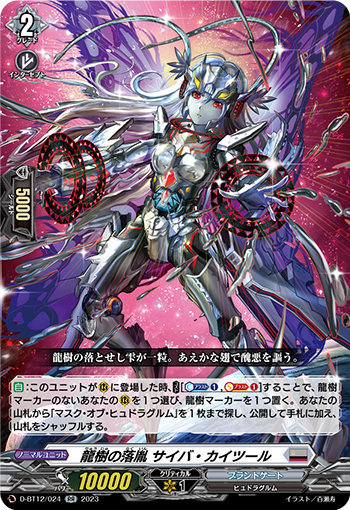

We should also briefly discuss the Dragontree Marker itself. For Orfist, a lot of times you will only have 1 Dragontree marker in a game unless you happen to have enough extra resources from healing throughout the game. Its even possible to not have a marker in some games. Placing the marker is usually quite straight foward as you will want to play it on a front row rearguard circle – something you want to call over using Orfist Masques.
Below is an example, using the Dragontree Marker and 1 Overcoming an Eternity it is very easy to break the 20k guard requirements, which is the standard in determining strong rearguards in the format right now.


Planning out a Strategy
Now that we understand what makes Orfist Masques tick, it’s easy to see its strengths compared to a normal Orfist deck. But as mentioned before, it is a Masque deck so we have to learn how to play an adaptable yet consistent game to make full use of all the tools. From my experience of trying to master the deck, it can take a while to get used to. So let’s first break down what we need in hand to set up a play.
The 2 Main Priorities will be getting the Masque of Hydragrum into our hand and ideally Orfist Masques – after that, we want World orders. One of the key parts of doing this is to make use of our ride deck discard – we can set some goals on how we want our drop zone to look. On our first G3 ride, we want to make use of Regis’s on-place skill but we also want to ensure that the Masque of Hydragrum will enter the drop zone. Riding up, we have 3 chances to discard a World so we can easily meet this requirement. But we do have to plan things out when we consider Orfist Masques.
The first big question is “Is Orfist Masques even in our hand?” Depending on whether we go first or not in aggressive match ups, we want to go into our Masques turn as soon as possible. If we do not have an Orfist Masques in hand, most of the time we will be forced to play the Masque of Hydragum on our turn 3 as our order for the turn to try and search for it rather than playing a World Order. In terms of our Order ratios and priorities, as a general rule it’ll be 1 Eclisped in played , 1-2 Eternity and the rest are Hollowing. Though there are some list that do play a copy of In the Darkness Nobody Knows as a way to tech in retire and also another different name to work with Polarxis.
Ideal Mulligans
So ideally we have one 1 World order at least, a Masque of Hydragum or Psyber Kaitul would be great and of course, Orfist Masques. We want 1 World order so that can guarantee 2 are played on T2 and T3 respectively to make sure Abyssal Dark Night is met on time. (Routis guaranteeing the second). While Polarxis is a strong card, it’s not something I would keep over the first few cards that we should prioritize.
Decision Making
With Orfist decision making comes as early as our first ride with Routis. Here we have to decide what World Orders we want to guarantee.
The most common and default one we go for is Hollowing Moonlight which is the main source of “advantage” and cycle we have in Orfist, this is what we go for if we find ourselves missing pieces we need to play down and especially if we do not have another World order to play. More cycling is always appreciated in a deck like this which is piece-reliant, to try to play out of brick hands.
However if we do already have have 1 Hollowing in our starting hand, we could prioritize finding an Overcoming an Eternity that we can discard and make use of Regis to activate for free as its normally quite a hassle to set from hand as the soulblast 2 cost is quite steep or even the alternative, Eclisped Moonlight. Which in my opinion is an important to get into play, as we can reuse that same Eclisped throughout the game with Orfist Masques and Polarxis.
Turn 2
Here are some common Turn 2 plays you could do depending on your situation. The first is relatively common. Where we play down Psyber and a Hollowing Moonlight to guarantee our Masque of Hydragrum and set up our World. I feel Psyber is best used at this turn of the game, as it sets up the Dragontree marker early, and guarantees the Masque of Hydragrum in hand. This is important as this grants us to flexibility to then choose on the following turn if we need to discard the Masque of Hydragrum for ride deck or something else if we need to rely on its search. A question then comes from this – if we already have 1 Masque of Hydragrum in hand, is it still worth it, to use Psyber this early?
While not as common, I would like to discuss the Eclipsed play on Turn 2. With Eclisped there are a few more intricacies, while we can use it to start rushing with skills like Cubisia, sometimes this could potentially lead us to be damage denied if we also play something like Psyber Kaitul in the same turn. Usually, this play is only reserved in situations where we already have our set up and would like to prioritize punishing rush with well, more rush. It does not come up too often but it should be highlighted.
Riding up to Orfist Masques
There are multiple ways you can go about playing your turn in Orfist Masques. Once again, we have to consider if we even have Orfist Masque to play or if we can go into at full power. Most of the time, especially going second, it is typically ideal to go into the Masque turn so that we can get that Persona Ride benefit. I recorded some videos to showcase, like what some of the common ways you could play out those. In general making 5 attacks is ideal, and this is the turn you really want to force the opponent to 5 dmg if possible . Or just cause a huge momentum shift with all your skills.
Let’s shift our focus to the strategy when going first with the deck. When playing Orfist, the decision of whether to rush into the Masque right away becomes a more debatable one. Regis remains a fairly potent vanguard early in the game when compared to some of the other Masque decks non-Masques Vanguards. Consequently, it might be advantageous to stick with Regis for that turn while setting up your World Orders for a more potent turn with Persona Ride next turn. This is particularly noteworthy if you have an Overcoming the Eternity Set, as it ensures that the Shadow Army called by Regis hits the 20k power mark exactly, making it excellent for dealing damage to Grade 2 vanguards.
While it’s possible to attempt to set up 4 Worlds on your first ride, this approach can be quite reliant on luck. In my opinion, unless you have have a Polarxis and a sufficient number of different Worlds in the drop zone, it’s often wiser to focus on playing the long game with Masques. This is another aspect to consider when piloting this deck. It is also not uncommon for many Orfist decks to play additional Orfist Regis in the deck as a result, because of how valuable the free set is. But it also can be used as a backup plan as a normal persona ride with Regis, making the deck that little more consistent.
Summary
With all that said, I hope I’ve not only piqued your interest but also convinced you that the Orfist Masques deck is a true powerhouse. It boasts a depth of strategic options that often go underestimated. The skill ceiling is high and I foresee it as a formidable contender in the ever-evolving metagame thanks to its remarkable adaptability. However, it does bear the hallmark of a Masque deck, which means there are occasional consistency hurdles to overcome, making it a daring choice for some.
Nonetheless, it demands our respect and might very well emerge as the standout deck of Set 12. Aspiring Orfist players, I wish you the best of luck, and remember, there’s still room for more experimentation with this thrilling deck!
Cipher
Sample Decklist
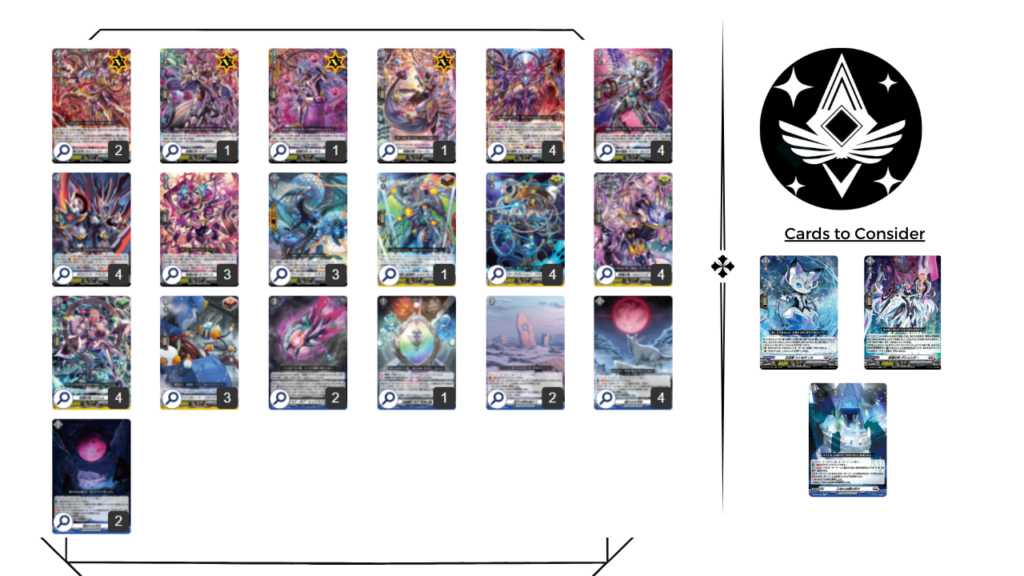
Thanks for reading this article. This is AsterismTCG, formerly Axis Vanguard, which has now expanded after a hiatus. I’ll still be covering mostly Vanguard content but do look forward to other things! I’ll try to keep things consistent this time!



